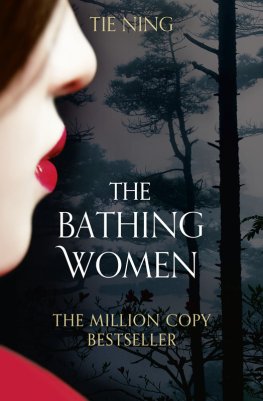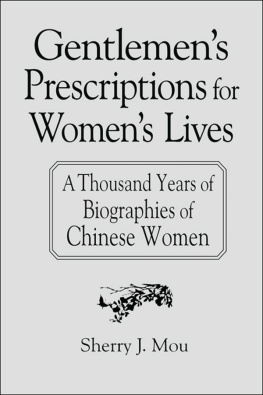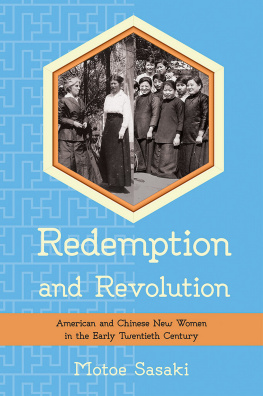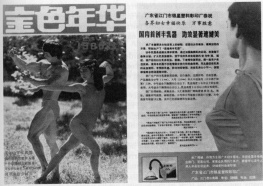CHINESE WOMEN
THROUGH CHINESE EYES
An East Gate Book
First published 1992 by M.E. Sharpe
Published 2015 by Routledge
2 Park Square, Milton Park, Abingdon, Oxon OX 14 4RN
711 Third Avenue, New York, NY 10017, USA
Routledge is an imprint of the Taylor & Francis Group, an informa business
Copyright 1992 Taylor & Francis. All rights reserved.
No part of this book may be reprinted or reproduced or utilised in any form or by any electronic, mechanical, or other means, now known or hereafter invented, including photocopying and recording, or in any information storage or retrieval system, without permission in writing from the publishers.
Notices
No responsibility is assumed by the publisher for any injury and/or damage to persons or property as a matter of products liability, negligence or otherwise, or from any use of operation of any methods, products, instructions or ideas contained in the material herein.
Practitioners and researchers must always rely on their own experience and knowledge in evaluating and using any information, methods, compounds, or experiments described herein. In using such information or methods they should be mindful of their own safety and the safety of others, including parties for whom they have a professional responsibility.
Product or corporate names may be trademarks or registered trademarks, and are used only for identification and explanation without intent to infringe.
Library of Congress Cataloging-in-Publication Data
Chinese women through Chinese eyes / edited by Li Yu-ning.
P. cm.
A collection of essays originally in Chinese
Includes bibliographical references.
ISBN 0-87332-596-6.ISBN 0-87332-597-4 (pbk.)
1. WomenChinaSocial conditions.
2. WomenChinaBiography.
I. Li, Yu-ning.
HQ1767.C454 1991
305.420951dc20
91-11313
CIP
ISBN 13: 9780873325974 (pbk)
ISBN 13: 9780873325967 (hbk)
To all men and women
East and West
who have helped Chinese women
in their search for a better future
Contents
____________
Li Yu-ning
Hu Shih
Yang Lien-sheng
Lin Y-tang
Chen Heng-che
Tseng Pao-sun
Sung Ching-ling
Li Yu-ning
Chang Mo-chn
Chen Heng-che
Ho Hsiang-ning
Teng Ying-chao
Hsieh Ping-ying
Hsiu-ying
Lu Lan
Fu I-hsing
Hung-ying
Anonymous
Hsiang-tsun
Ah-jung
Pan Chi-chn
Chiang Ching
Li Y-chin
Chen Hsueh-chao
Preface and
Acknowledgments
____________
Of the many things I have acquired in the United States, one of the most valuable is an appreciation of cultural pluralism. In life and in the study of history I have become increasingly convinced that a variety of cultural perspectives can shed more and better light on any subject, and thereby make any study more stimulating and rewarding. From the historical point of view, human experience and cultural values are perpetually in flux; neither remains permanent, neither is absolute. Born and raised in a Chinese cultural environment and educated in Chinese and American universities, I am acutely aware of the ways each stage of my life influenced my views of my own past as well as my interpretations of historical events.
A major aspect of pluralism is gender equality, in the study of history as well as in life. For some years now I have been working on Chinese womens history, at first collecting and publishing documents and then increasingly thinking about new ways of interpreting the complex history of the many and diverse experiences of Chinese women through Chinas long history. The rise of feminist scholarship in the United States and Europe has opened up many exciting new approaches and fields. Stimulated by this scholarship, I became interested in Chinese perspectives on Chinese women. In particular, I became increasingly curious about earlier Chinese ideas concerning the history and status of women, and then fascinated by the ways Chinese women in the early twentieth century viewed their own changing world and lives.
This volume is the result of a combination of these interests and my teaching responsibilities. Preparing for my seminars on Chinese women at St. Johns University has made me appreciate all the more the excellent works already in print as well as making me aware of the gaps that remain to be filled. Chinese Women Through Chinese Eyes is an attempt to fill one of these gaps by presenting earlier Chinese perspectives on womens status in Chinese society and on prospects for the future. It is also an attempt to repay the debt I owe all those who have stimulated my thinking on the subject.
I would like to thank St. Johns for giving me the opportunity to develop new courses and for providing me with the research support I needed to begin work on this book. Special thanks go to Dr. Barbara L. Morris, academic vice-president, Dr. Paul T. Medici, dean of the Graduate School of Arts and Science, and Dr. and Sr. Virginia Therese Johnson, former director of Asian studies at St. Johns, for their long-standing support and encouragement. Mrs. Sandra M. Esposito was most kind in typing a large part of the manuscript. I have also greatly benefited from discussions with and questions and suggestions from my students over the years.
I have been associated with M. E. Sharpe for over two decades, and, for their help in general as well as their work on this book, I would like to thank in particular Mr. Douglas Merwin, Ms. Anita OBrien for her skillful editing, and Ms. Helen Albert for her friendship and interest in my work.
were translated by Dr. William A. Wycoff and first appeared in Chinese Studies in History. I am sure that readers will share my appreciation of Dr. Wycoffs lucid translations.
My husband, Professor J. Mason Gentzler, has been helpful and supportive in innumerable ways since the beginning of this project. His constant encouragement has been important in bringing it to completion. In addition, he translated . Moreover, he helped with the tedious task of reading the galley proofs.
In spite of my great indebtedness to so many people, I remain solely responsible for whatever defects remain.
Most of the essays in were originally published earlier in the century, when romanization was far less uniform than now. For the sake of consistency, where possible, romanization has been altered to conform to the Wade-Giles system. Some minor stylistic alterations have also been made, and, in a few cases, footnotes have been rearranged or renumbered. The Chinese characters contained in some of the articles as originally published have been deleted.
Li Yu-ning
Bronxville, New York
May 1991
____________
Li Yu-ning
The study of Chinese women has made great progress in recent years, with the publication of a number of excellent articles, collections of articles, and monographs. The range of subjects has been wide, from palace women in the Sung dynasty to women in contemporary Chinese villages, but the principal focus has been on the post-1949 period, because of the availability of sources and because of widespread interest in the changes in status of Chinese women in the Peoples Republic of China. Earlier periods have not been neglected, and impressive studies are not lacking, but much remains to be done.







